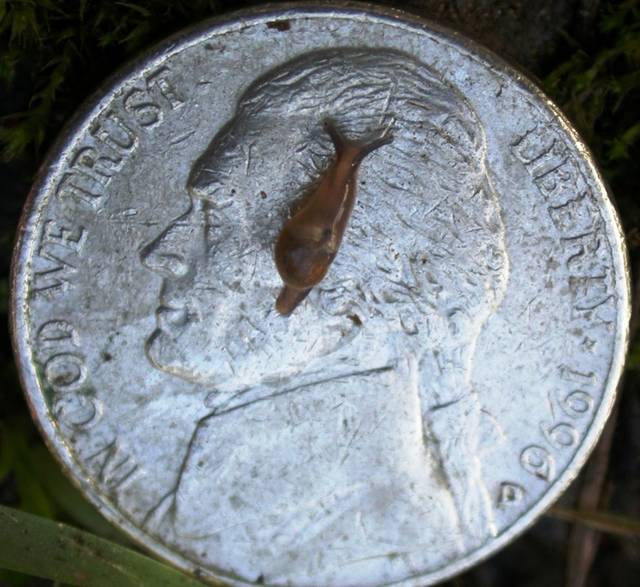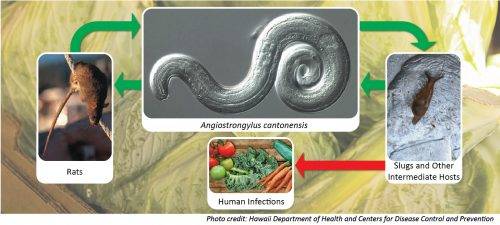Legislation pushes new DOH positions, requirements to combat rat lungworm disease

Snails, even as small as the one pictured here, can be carriers of the parasite causing rat lungworm disease. (State Department of Health/Courtesy photo)

Humans can contract rat lungworm disease by eating food contaminated with slugs or snails, or their slime. (Hawaii Department of Health and CDC/Courtesy photo)
KAILUA-KONA — Hawaii Island Rep. Richard Creagan and the Hawaii County Council don’t think the Hawaii Department of Health is as serious as it should be about rat lungworm disease.
KAILUA-KONA — Hawaii Island Rep. Richard Creagan and the Hawaii County Council don’t think the Hawaii Department of Health is as serious as it should be about rat lungworm disease.
The Health and Human Services Committee’s deferral of House Bill 2663 Thursday morning only solidified that position.
The measure, introduced by Creagan, doesn’t speak to rat lungworm directly. Instead, it would require each county’s District Health Officer (DHO) to be a trained physician, which Creagan said would bring more expert attention to serious issues like permanent disabilities caused by the rat lungworm now afflicting several Big Island residents.
DHOs on Kauai and Maui are trained physicians. Hawaii Island’s DHO, Aaron Ueno, is not.
A Hawaii County Council resolution, introduced by Puna councilwoman Eileen O’Hara, supporting Creagan’s bill passed committee unanimously on Wednesday. O’Hara also submitted written testimony to the HHS Committee in favor of the measure.
Creagan contends the lack of a trained physician as DHO has hampered response to disease outbreaks on Hawaii Island, such as the dengue fever outbreak of 2015-16 and several cases of rat lungworm last year. He asserted in his bill that Maui has handled similar problems more competently under the guidance of its DHO, Lorrin Pang, M.D.
“If you have somebody with boots on the ground in Hilo who is a physician, they can push the health department on behalf of the community,” Creagan said. “They’re going to stand up for the Big Island against the health department.”
Creagan went on to describe DOH as “dysfunctional,” particularly in regard to disease outbreaks. He cited state auditor report 17-14, which offered a highly critical review of DOH and its Disease Outbreak Control Division’s responses to recent disease outbreaks in Hawaii, including the recent dengue epidemic on the Big Island.
The report states DOH and its outbreak division suffered communication breakdowns, failed to establish proper guidance for other agency officials and didn’t conduct proper reviews after outbreaks concluded, among other criticisms.
Creagan said a knowledgeable physician serving Hawaii Island as DHO would bolster responses, but added Hawaii State Epidemiologist Dr. Sarah Park, who heads the DOCD, is averse to any outer island opposition.
“Sarah Park says ‘Oh, (rat lungworm) is a lifestyle disease over there,” Creagan said. “She’s blaming the victim. So we need someone on the ground there.”
DOH offered testimony opposing Creagan’s bill, asserting the scope of a DHO’s job encompasses issues of public health, environmental health and behavioral health beyond a physician’s expertise.
Park took exception to Creagan’s characterization of her response to incidences of rat lungworm in Puna as “blaming the victim,” saying assigning blame isn’t what epidemiologists do.
She added, however, that looking at what people eat and drink and where they procure that sustenance is pertinent to the spread and containment of rat lungworm disease.
Park also said while a trained clinician serving as Hawaii Island’s DHO may offer a benefit in the form of a different perspective on a case-by-case basis, it wouldn’t meaningfully improve disease outbreak response.
“In public health, we do not provide health care,” Park said. “So to assume that a clinician in public health would then somehow effect a change in terms of making certain we have a better response, I don’t think that’s necessarily the case.”
DOH also noted in its testimony that recruiting a physician to the position of DHO is difficult because clinicians can make more money in the private sector.
“The licensed health care professional salary schedule for physicians in managerial positions is between $125,424 – $306,840,” DOH spokesperson Janice Okubo wrote in an email.
Creagan characterized the financial argument as an excuse, saying the Legislature would gladly appropriate more funding to make the position competitive enough to attract the desired candidate.
While HB2663 has been deferred, Creagan said he is in talks with HHS Committee chair John Mizuno about progressing the DHO requirement via a different legislative vehicle.
A second bill introduced by Creagan that gets at the rat lungworm problem in a roundabout way is House Bill 2498, which would fund a veterinary medical officer position within DOH on a permanent basis.
The position would focus on zoonotic diseases like rat lungworm, which can pass between animals and people.
The measure, which was also heard by the HHS Committee Thursday morning, passed with amendments despite DOH opposition.
DOH acknowledged in its testimony that bringing the position back would be helpful, but also noted that other members of the department, namely Park, have absorbed the relevant responsibilities and work in conjunction when necessary with the Department of Agriculture and the Hawaii State Veterinarian.
The department’s testimony again mentioned money as a concern. Okubo wrote in an email that DOH projects the cost of adding a veterinary medical officer position would amount to around $120,000 annually based on salaries for similar positions on the mainland.
Creagan’s rebuttal was similar to his retort to DOH arguments opposing HB2663.
“They just let that position lapse because I think they just don’t want anybody challenging them within that department,” Creagan said.
He explained the problem of rat lungworm is spreading beyond humans to other dead-end mammalian hosts, rendering the proposed position more crucial.
“Informally talking to people, we can confirm that there have been cases in dogs, cats and horses,” Creagan said.
He added nearly every department of health in the nation staffs a permanent veterinary medical officer or an equivalent position and that the expertise such an employee could provide would prove valuable as funds for rat lungworm research have been hard to come by.
Big Island Sen. Russell Ruderman said he’s been trying for three years to secure funding for research at the rat lungworm lab within the Daniel K. Inouye College of Pharmacy at the University of Hawaii at Hilo.
The $1 million set for that research, appropriated in 2017 and to be distributed evenly over two years, was diverted away from research purposes at the lab and sent instead to DOH for education and vector control — money the department did not request.
The last minute diversion was due to unrelated political infighting in the Legislature last year, Ruderman said, leaving the lack of research as collateral damage.
Puna councilwoman Jen Ruggles said such research would include identification of safe catchment filters and the development of anti-parasite drugs. Because there’s been no money for research, she added, the County Council has been forced to scrape together contingency funds to share the cost of a preliminary study.
“I wish the DOH would take the rat lungworm disease more seriously,” she said.



Rat lung disease is the result from many possible environmental carriers and paths from rat droppings..
Hawaii State Epidemiologist Dr. Sarah Park suggests that human hygiene promotes the movements of the vector.
Other State officials are hesitant to be involved for administrative reasons and the high cost of expertise. personnel.
All of this rationale amount to denials.